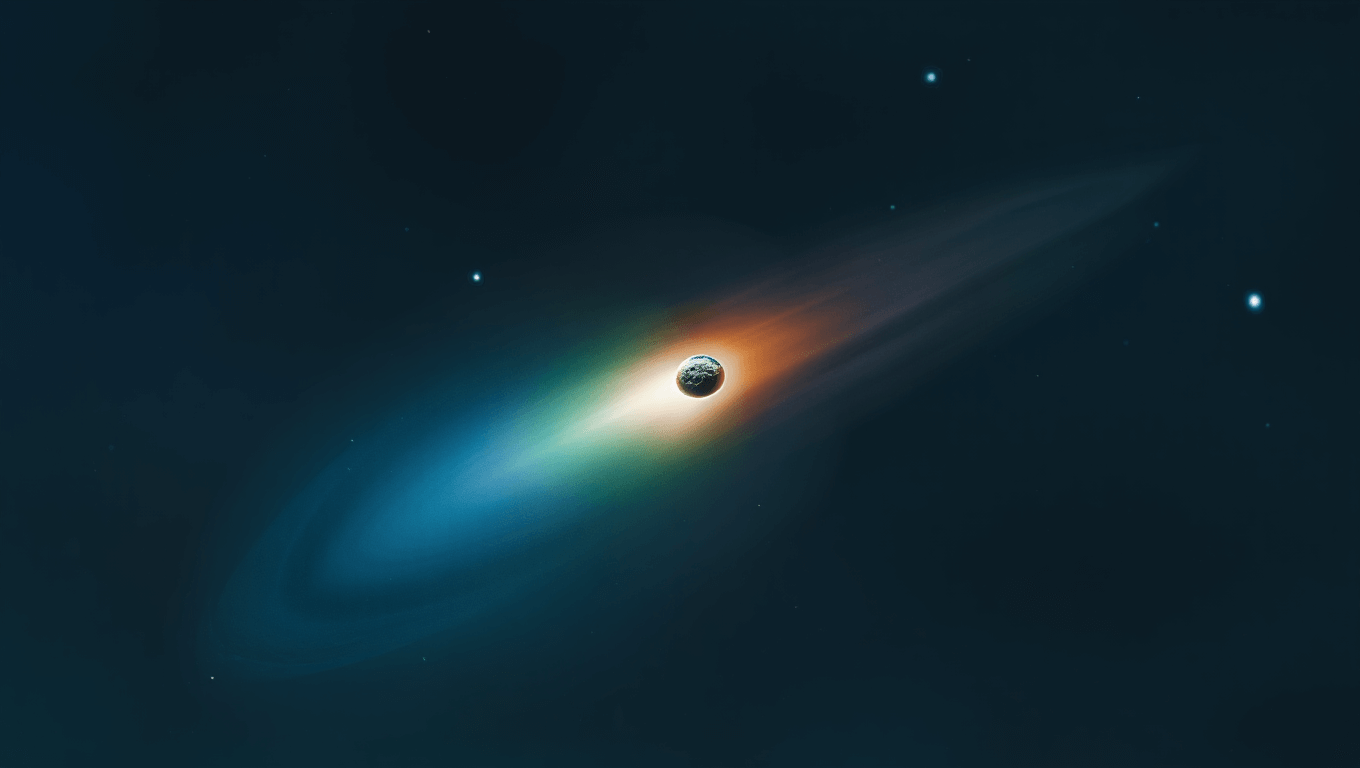Interstellar comet 3I/ATLAS reaches its epic closest point to the Sun this week. On October 29, 2025, this rare visitor from beyond our galaxy arrives at perihelion. Scientists just discovered shocking amounts of nickel vapor surrounding it. The mysterious cosmic traveler won’t threaten Earth but promises stunning discoveries.
🔥 Quick Facts:
- 3I/ATLAS reaches the Sun at 1.36 AU (210 million km) on Oct. 29
- Detected glowing nickel vapor at extraordinary distances from heat source
- Only the 3rd known interstellar object ever discovered passing through our solar system
- Traveling at 137,000 miles per hour when first spotted in July 2025
- Won’t come closer than 170 million miles (1.8 AU) to Earth
What Makes 3I/ATLAS Incredibly Special
3I/ATLAS just entered an exclusive club. On July 1, 2025, NASA’s ATLAS telescope in Chile discovered this visitor. It’s only the third confirmed interstellar object in known history. Before it, we’d seen ʻOumuamua (2017) and 2I/Borisov (2019). This comet follows a hyperbolic trajectory, meaning it’ll never return. Solar gravity can’t hold it here forever. It came from another star system billions of years ago.
“The interstellar comet 3I/ATLAS is actively outgassing, meaning it has an icy nucleus and coma of gas and dust, classifying it as a comet rather than an asteroid.”
Astronomers across the globe watched this visitor approach the Sun. The comet won’t become brighter or visible to your naked eye. Powerful telescopes tracked it through early September. Then it hid behind the Sun. Around early December, it’ll reappear in predawn skies.
The Surprising Nickel Discovery That Shocked Scientists
Here’s where things got really interesting. Scientists detected something completely unexpected. They found glowing nickel vapor surrounding the comet at extraordinary distances. The Sun’s warmth at that distance should never vaporize metals into gas. When researchers examined the data, the nickel-to-iron ratio proved extraordinary too. Natural comets show iron and nickel together. This one had nickel essentially alone.
The detection happened using advanced spectroscopic analysis from multiple observatories. NASA’s Hubble Space Telescope captured images showing a teardrop-shaped dust cocoon. The nucleus diameter ranges from 1,444 feet to 3.5 miles across. Webb Space Telescope and SPHEREx mission also observed the comet’s unusual chemical signatures in August. Every measurement strengthened the mystery.
| Key Observation | Details |
|---|---|
| Discovery Date | July 1, 2025 by ATLAS telescope, Rio Hurtado, Chile |
| Perihelion Date | October 29-30, 2025 (closest point to Sun) |
| Distance at Perihelion | 1.36 AU or 203 million km (126 million miles) |
| Speed | 137,000 mph (221,000 km/h) and accelerating |
| Nucleus Size | 1,444 feet to 3.5 miles diameter (estimated) |
| Closest Approach to Earth | 1.8 AU or 170 million miles (270 million km) |
What Scientists Will Watch For This Week
October 29, 2025 marks the critical moment everybody’s waiting for. The comet hits its perihelion, its closest point to solar heat. Activity levels should spike dramatically. The outgassing will intensify. Chemical emissions might reveal clues about its home star system. Multiple NASA spacecraft positioned strategically should observe crucial data.
- The Parker Solar Probe and SOHO spacecraft will track heat interactions
- Mars Reconnaissance Orbiter already passed it on October 3 at 29 million km away
- Ground-based telescopes worldwide will document any brightness changes or jets
- The mysterious anti-tail spotted by Keck II might extend further
- Scientists expect reappearance in predawn skies around December 2025
After reaching the Sun, the comet will loop around and head outbound. By March 2026, it’ll sail past Jupiter’s orbit toward interstellar space. We may never see anything like this again. The chances of another interstellar visitor arriving soon remain incredibly slim.
Why This Week Changes What We Know About Comets
For centuries, astronomers assumed all comets came from our solar system’s distant Oort Cloud or Kuiper Belt. The recent discoveries of ʻOumuamua, 2I/Borisov, and now 3I/ATLAS proved scientists wrong. Visitors from other star systems pass through regularly. They carry clues about chemistry elsewhere in the galaxy. Each observation helps us understand how planets form around distant stars.
The nickel discovery particularly fascinates researchers. Chemical compositions tell stories about formation temperatures and stellar environments. The unusual nickel-without-iron signature suggests either extreme conditions or truly exotic chemistry. Scientists aren’t ruling out anything yet. By December, deeper analysis of the data will emerge. Universities worldwide submitted research proposals to study this comet’s passing. The scientific payoff could reshape our understanding of the cosmos itself.
This cosmic visitor forces us to rethink our vantage point. Earth sits in a bustling cosmic highway. Travelers from distant stars regularly cruise past. We’re only now building telescopes powerful enough to notice. What other secrets are drifting through our solar system right now, just beyond detection? History suggests we haven’t seen the last surprise.
Sources
- NASA Science – Official Comet 3I/ATLAS documentation and trajectory data
- Space.com – Surprising nickel detection analysis and observational findings
- Live Science – Current perihelion approach updates and scientific implications
Similar posts:
- 3I/ATLAS releases mysterious nickel vapor as comet approaches Sun Oct. 29
- 3I/ATLAS sparks alien speculation as ‘Black Swan’ comet reaches closest point to Sun Oct 29
- Baba Vanga’s alien prophecy ignites global debate as mysterious comet 3I/ATLAS approaches Earth in November
- Baba Vanga’s 2025 alien prophecy sparks global debate as mysterious comet 3I/ATLAS passes Earth
- Nostradamus sparks viral fears with 2025 end-of-year predictions, 3I/ATLAS cosmic event linked

Daniel Harris is a specialist journalist focused on the crossroads of breaking news, extraordinary history, and enduring legends. With a background in historical research and storytelling, he blends timely reporting with timeless narratives, making complex events and ancient myths resonate with today’s readers. Daniel’s work often uncovers surprising links between present-day headlines and legendary tales, offering unique perspectives that captivate diverse audiences. Beyond reporting, he is passionate about preserving oral traditions and exploring how extraordinary stories continue to shape culture and identity.


You’ve contradicted yourself. You state “We may never see anything like this again. The chances of another interstellar visitor arriving soon remain incredibly slim.” Then it is immediately followed by “The recent discoveries of ʻOumuamua, 2I/Borisov, and now 3I/ATLAS proved scientists wrong. Visitors from other star systems pass through regularly.”